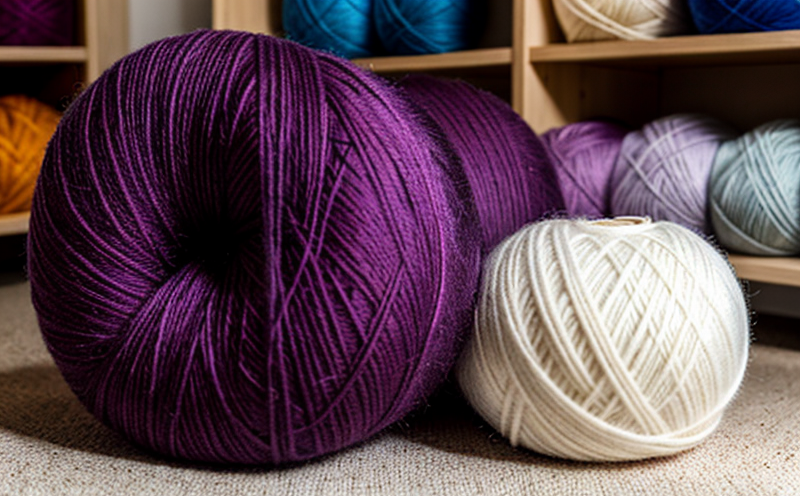DIN 53832 Yarn Tensile Strength and Elongation
The DIN 53832 standard is a crucial test method used in the textile industry to determine the tensile strength and elongation properties of yarns. This test provides valuable insights into the mechanical performance of yarns, which are fundamental components in fabric production.
Understanding the tensile properties of yarns is essential for ensuring quality control, material selection, and product design within the textile sector. Yarns with superior tensile strength can withstand higher stress levels without breaking, contributing to more durable fabrics. Similarly, knowing the elongation capacity helps in understanding how much a yarn will stretch before it breaks, which is critical for achieving the desired fabric hand and appearance.
For quality managers and compliance officers, this test ensures that the products meet required specifications set by international standards such as DIN 53832. R&D engineers use these results to innovate and improve product designs, while procurement teams rely on these data points when selecting suppliers and materials.
The test procedure involves subjecting yarn specimens to controlled tensile forces until failure occurs. The maximum load the specimen can withstand before breaking is recorded as the tensile strength. Simultaneously, the elongation at break measures how much the yarn stretches during this process. These measurements are essential for textile manufacturers and users to evaluate the quality and performance of their products.
The instrumentation used in this test includes a mechanical testing machine capable of applying precise loads while measuring displacement accurately. The specimens undergo preparation by cutting them into standard lengths, ensuring uniformity across multiple samples. Proper specimen preparation is critical as it directly impacts the test results’ reliability.
The acceptance criteria for DIN 53832 are strictly defined and outlined in the standard itself. Compliance with these criteria ensures that the test results are accurate and comparable between different laboratories worldwide. Laboratories adhering to this protocol can provide reliable, repeatable data, which is essential for quality assurance processes.
While the primary application of DIN 53832 lies within the textile industry, its principles are applicable across various sectors where high-quality yarns are required. For instance, in medical textiles, ensuring that surgical threads have adequate tensile strength and elongation properties can mean the difference between successful procedures and complications.
Understanding the importance of these mechanical properties allows textile manufacturers to make informed decisions regarding material selection and process optimization. By incorporating DIN 53832 into their quality control processes, companies can enhance product performance, reliability, and customer satisfaction.
Why Choose This Test
Selecting the DIN 53832 test for yarn tensile strength and elongation is a strategic decision that offers several advantages. Firstly, it ensures consistent quality across all batches of yarns produced by manufacturers. Compliance with this standard guarantees that each batch meets predefined mechanical performance criteria, enhancing product reliability.
Secondly, using DIN 53832 enables companies to establish robust quality assurance protocols. By adhering to these standards, textile producers can demonstrate their commitment to maintaining high-quality products and meeting customer expectations consistently.
A third advantage is the ability to compare results across different laboratories easily. As this test method is widely recognized internationally, it facilitates seamless communication among manufacturers, suppliers, and end-users from various regions. This interoperability fosters trust within global supply chains and promotes international trade.
Moreover, implementing DIN 53832 helps textile companies stay competitive in an increasingly demanding market. By ensuring that their products meet or exceed the specified mechanical performance criteria, they can differentiate themselves from competitors offering substandard materials.
In addition to these benefits for manufacturers, choosing this test method also serves other stakeholders such as quality managers and compliance officers who oversee compliance with regulatory requirements. It ensures that all parties involved in textile production understand precisely what is expected of them regarding mechanical property testing.
Finally, adopting DIN 53832 contributes positively to the environment by promoting sustainable practices within the industry. By selecting high-performance yarns capable of enduring rigorous usage conditions without compromising quality or durability, manufacturers can reduce waste and extend product lifecycles, leading to more efficient resource utilization overall.
International Acceptance and Recognition
- DIN 53832 is recognized globally for its reliability in evaluating yarn tensile strength and elongation properties. Its widespread adoption by textile manufacturers ensures consistent quality standards across different regions.
- The standard’s acceptance extends beyond Europe, making it a preferred choice for international buyers seeking to source high-quality yarns from reputable suppliers around the world.
- Compliance with DIN 53832 helps companies meet regulatory requirements in various countries, fostering compliance and trust among customers.
- Many leading brands incorporate this testing method into their supply chain management systems to ensure product consistency and reliability.
Environmental and Sustainability Contributions
The adoption of DIN 53832 not only enhances the quality of textile products but also plays a significant role in promoting environmental sustainability. By selecting high-performance yarns that meet stringent mechanical performance criteria, manufacturers contribute to reducing waste generation during production processes.
Additionally, ensuring durability through proper tensile strength and elongation testing reduces the need for frequent replacements or repairs, extending product lifecycles significantly. This leads to more efficient resource utilization, thereby conserving natural resources and minimizing environmental impact.
Furthermore, compliance with international standards like DIN 53832 encourages innovation in sustainable textile manufacturing practices. Companies that adhere to such rigorous testing methods often invest in research aimed at developing eco-friendly materials while maintaining superior mechanical properties.
In summary, the implementation of DIN 53832 contributes positively towards achieving broader sustainability goals within the textile industry by fostering responsible production processes and promoting resource efficiency.





